THE MTU BRUSH SEAL DESIGN - MTU Aero Engines
THE MTU BRUSH SEAL DESIGN - MTU Aero Engines
THE MTU BRUSH SEAL DESIGN - MTU Aero Engines
Create successful ePaper yourself
Turn your PDF publications into a flip-book with our unique Google optimized e-Paper software.
ÃÃÃÃÃÃÃÃÃÃÃÃ<br />
Alfons Gail<br />
Stefan Beichl<br />
<strong>MTU</strong> <strong>Aero</strong> <strong>Engines</strong>, Munich, Germany<br />
<br />
This report deals with the principles of design and fabrication of the <strong>MTU</strong> Brush Seal which use a unique<br />
manufacturing technique. While other brush seal suppliers around the world use a fabrication process<br />
which entails the 0.07 mm thin wires being secured by a welding process, <strong>MTU</strong> has developed and<br />
patented a method which uses only mechanical joining techniques, such as clamping and swaging. In<br />
doing so, the welding process required to fix the bristles has completely been eliminated.<br />
In the following the advantages inherent in the <strong>MTU</strong> seal design are explained and an insight is given<br />
into the current range of applications. Additionally some results obtained by rig and engine testing are<br />
presented which confirm the functionality, performance and life of <strong>MTU</strong> Brush Seals.<br />
Particular attention is paid to the most significant drawbacks brush seals have to cope with, like blow<br />
down effect, hang-up effect, high operational bristle stiffness, and it is shown that the <strong>MTU</strong> seal design<br />
has either resolved or reduced them to a negligible degree.<br />
The paper concludes that the development undertaken so far with <strong>MTU</strong> Brush Seals paves the way for<br />
making the brush seal a highly competitive element for a variety of future applications.<br />
<br />
1. History<br />
Back in 1983 <strong>MTU</strong> Munich commenced to manufacture brush seals initially applying welding techniques<br />
of the “conventional” seal design. After a series of welding problems became apparent, a new method for<br />
bristle retention was sought in order to delete welding processes.<br />
After numerous attempts, a promising new method to fix the bristles was developed and established.<br />
This method was applied for patent in 1985. The first <strong>MTU</strong> Brush Seals were rig tested in 1986 and<br />
engine testing commenced in 1992. Based on successful engine testing the number of <strong>MTU</strong> Brush Seal<br />
applications in both military and civil engines have increased steadily. Meanwhile <strong>MTU</strong> Brush Seals are<br />
validated at challenging positions where brush seals are successfully applied the first time.<br />
Testing of <strong>MTU</strong> Brush Seals for industrial gas turbine and compressor applications started in 1996. Since<br />
1998 <strong>MTU</strong> Brush Seals are delivered for flight and industrial production engines.<br />
2. The Conventional Brush Seal Design<br />
Fig. 1 shows the conventional brush seal design consisting of a backing plate, retaining ring and bristle<br />
pack. The brush seal is formed by squeezing the bristle pack between the backing plate and the<br />
retaining ring followed by circumferential welding to join these three elements to one unit. For more<br />
details see Ref. 1. Basically, the philosophy that is pursued by the conventional seal design is to fix the<br />
bristles at the outer end via the welding seam, whereas the inner end contacts the mating runner.<br />
The following requirements have to be fulfilled:<br />
• Safe retention of every single bristle (bristle diameter usually 0.07 mm (.0028 in))<br />
• No coning of backing plate<br />
• No distortion of side plates<br />
• Constant penetration depth of weld material into the bristle pack


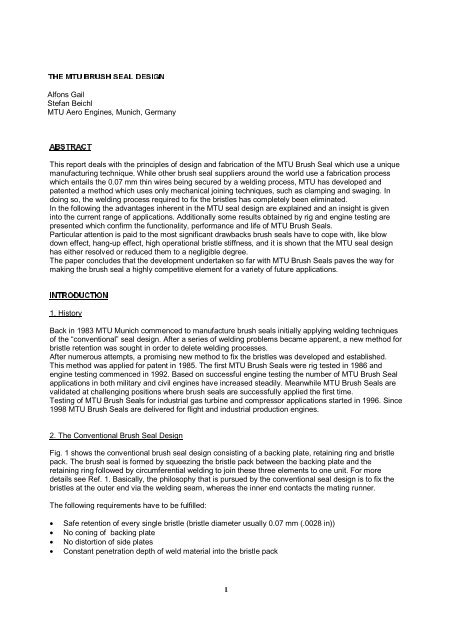


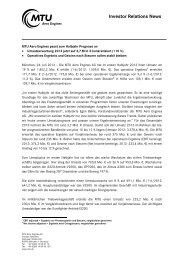
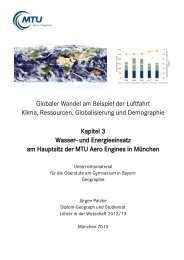
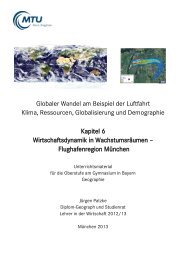
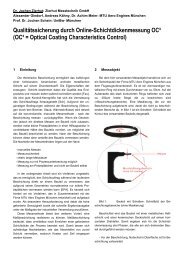
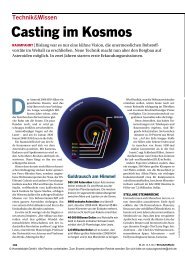

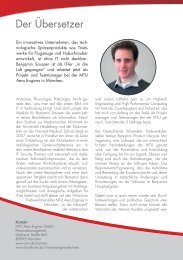
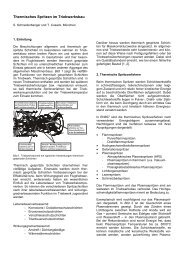
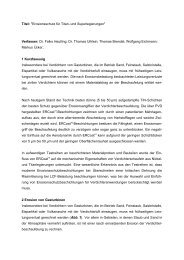


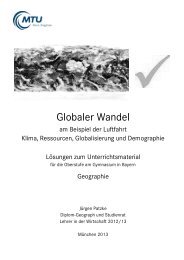
![Download PDF [5,37 MB] - MTU Aero Engines](https://img.yumpu.com/21945461/1/190x125/download-pdf-537-mb-mtu-aero-engines.jpg?quality=85)